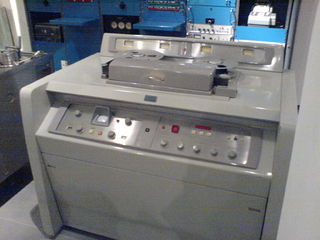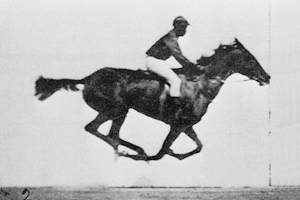Related Research Articles

Pan and scan is a method of adjusting widescreen film images so that they can be shown in fullscreen proportions of a standard definition 4:3 aspect ratio television screen, often cropping off the sides of the original widescreen image to focus on the composition's most important aspects.
Frame rate is the frequency (rate) at which consecutive images called frames appear on a display. The term applies equally to film and video cameras, computer graphics, and motion capture systems. Frame rate may also be called the frame frequency, and be expressed in hertz.

Interlaced video is a technique for doubling the perceived frame rate of a video display without consuming extra bandwidth. The interlaced signal contains two fields of a video frame captured consecutively. This enhances motion perception to the viewer, and reduces flicker by taking advantage of the phi phenomenon.

In photography, shutter speed or exposure time is the length of time when the film or digital sensor inside the camera is exposed to light, also when a camera's shutter is open when taking a photograph. The amount of light that reaches the film or image sensor is proportional to the exposure time. 1⁄500 of a second will let half as much light in as 1⁄250.
Slow motion is an effect in film-making whereby time appears to be slowed down. It was invented by the Austrian priest August Musger in the early 20th century. This can be accomplished through the use of high-speed cameras and then playing the footage produced by such cameras at a normal rate like 30 fps, or in post production through the use of software add-ons such as Twixtor.
Bullet time is a visual effect or visual impression of detaching the time and space of a camera from those of its visible subject. It is a depth enhanced simulation of variable-speed action and performance found in films, broadcast advertisements, and realtime graphics within video games and other special media. It is characterized both by its extreme transformation of time and space. This is almost impossible with conventional slow motion, as the physical camera would have to move implausibly fast; the concept implies that only a "virtual camera", often illustrated within the confines of a computer-generated environment such as a virtual world or virtual reality, would be capable of "filming" bullet-time types of moments. Technical and historical variations of this effect have been referred to as time slicing, view morphing, temps mort and virtual cinematography.

A video tape recorder (VTR) is a tape recorder designed to record and play back video and audio material on magnetic tape. The early VTRs were open-reel devices which record on individual reels of 2-inch-wide tape. They were used in television studios, serving as a replacement for motion picture film stock and making recording for television applications cheaper and quicker. Beginning in 1963, videotape machines made instant replay during televised sporting events possible. Improved formats, in which the tape was contained inside a videocassette, were introduced around 1969; the machines which play them are called videocassette recorders.
Deinterlacing is the process of converting interlaced video into a non-interlaced or progressive form. Interlaced video signals are commonly found in analog television, digital television (HDTV) when in the 1080i format, some DVD titles, and a smaller number of Blu-ray discs.
1080i is a combination of frame resolution and scan type. 1080i is used in high-definition television (HDTV) and high-definition video. The number "1080" refers to the number of horizontal lines on the screen. The "i" is an abbreviation for "interlaced"; this indicates that only the odd lines, then the even lines of each frame are drawn alternately, so that only half the number of actual image frames are used to produce video. A related display resolution is 1080p, which also has 1080 lines of resolution; the "p" refers to progressive scan, which indicates that the lines of resolution for each frame are "drawn" on the screen in sequence.

576i is a standard-definition video mode originally used for terrestrial television in most countries of the world where the utility frequency for electric power distribution is 50 Hz. Because of its close association with the colour encoding system, it is often referred to as simply PAL, PAL/SECAM or SECAM when compared to its 60 Hz NTSC-colour-encoded counterpart, 480i. In digital applications it is usually referred to as "576i"; in analogue contexts it is often called "625 lines", and the aspect ratio is usually 4:3 in analogue transmission and 16:9 in digital transmission.

Time-lapse photography is a technique whereby the frequency at which film frames are captured is much more spread out than the frequency used to view the sequence. When played at normal speed, time appears to be moving faster and thus lapsing. For example, an image of a scene may be captured at 1 frame per second, but then played back at 30 frames per second; the result is an apparent 30 times speed increase. In a similar manner, film can also be played at a much lower rate than at which it was captured, slowing down an otherwise fast action, as in slow motion or high-speed photography.
In video, a field is one of the many still images which are displayed sequentially to create the impression of motion on the screen. Two fields comprise one video frame. When the fields are displayed on a video monitor they are "interlaced" so that the content of one field will be used on all of the odd-numbered lines on the screen and the other field will be displayed on the even lines. Converting fields to a still frame image requires a process called deinterlacing, in which the missing lines are duplicated or interpolated to recreate the information that would have been contained in the discarded field. Since each field contains only half of the information of a full frame, however, deinterlaced images do not have the resolution of a full frame.

Digital cinematography is the process of capturing (recording) a motion picture using digital image sensors rather than through film stock. As digital technology has improved in recent years, this practice has become dominant. Since the mid-2010s, most movies across the world are captured as well as distributed digitally.
In filmmaking, video production, animation, and related fields, a frame is one of the many still images which compose the complete moving picture. The term is derived from the fact that, from the beginning of modern filmmaking toward the end of the 20th century, and in many places still up to the present, the single images have been recorded on a strip of photographic film that quickly increased in length, historically; each image on such a strip looks rather like a framed picture when examined individually.
This article discusses moving image capture, transmission and presentation from today's technical and creative points of view; concentrating on aspects of frame rates.

High-speed photography is the science of taking pictures of very fast phenomena. In 1948, the Society of Motion Picture and Television Engineers (SMPTE) defined high-speed photography as any set of photographs captured by a camera capable of 69 frames per second or greater, and of at least three consecutive frames. High-speed photography can be considered to be the opposite of time-lapse photography.

Image stabilization (IS) is a family of techniques that reduce blurring associated with the motion of a camera or other imaging device during exposure.
Television standards conversion is the process of changing a television transmission or recording from one television system to another. The most common is from NTSC to PAL or the other way around. This is done so television programs in one nation may be viewed in a nation with a different standard. The video is fed through a video standards converter, which makes a copy in a different video system.
Display motion blur, also called HDTV blur and LCD motion blur, refers to several visual artifacts that are frequently found on modern consumer high-definition television sets and flat panel displays for computers.
UPI Newstime was a cable television network founded by United Press International in 1978, and premiering July 3 of that year. UPI Newstime was the second 24-hour all-news television network in the US for cable TV, following AP Newscable for 13 years and predating CNN by 2 years. UPI Newstime was unique in how it distributed its programming to local cable TV (CATV) headends via satellite, using a form of slow-scan television, or SSTV technology. Using SSTV reduced satellite transmission costs for UPI and was suitable at the time for the programming produced by UPI for the channel, which mainly relied on still slides and wirephotos acquired by UPI's own newsgathering operations.
References

| This article about television technology is a stub. You can help Wikipedia by expanding it. |